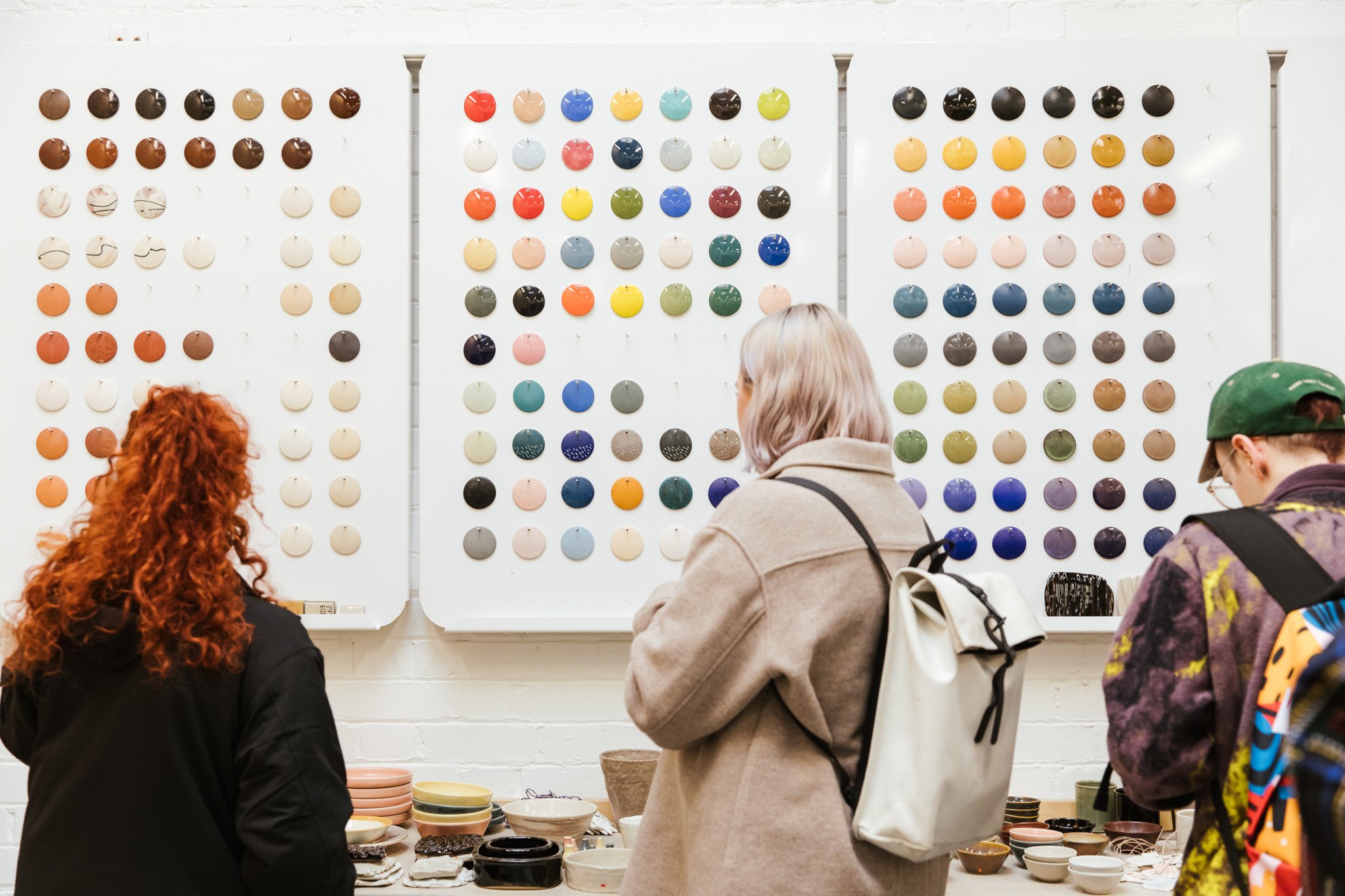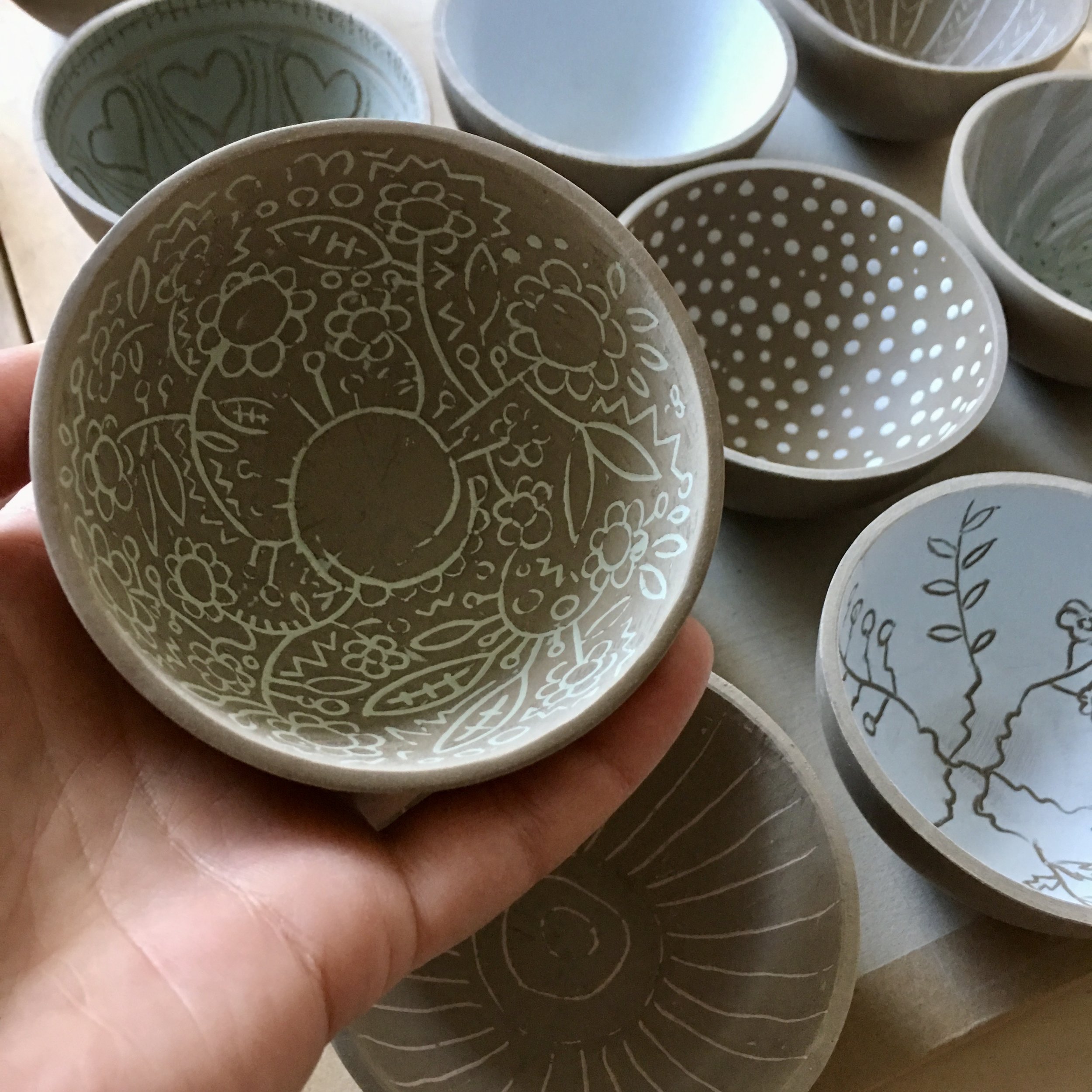Colour and Surface
Glaze, clay, underglaze, slip, coloured clay and Egyptian paste samples at Sunken Studio.
Our disc boards inject a bit of pop in to an otherwise neutral space. They were made to show how different oxides respond to three basic glazes and red and white clay bodies. The middle board showcases underglaze colours we were using up to 2020, clays coloured with stains, and Egyptian paste experiments.
The glaze palette at the studio is basic. There were 3 in use when we made the disc boards and now there are up to 10 glazes in circulation, for use by our members and in classes, at any one time. Chris also has boxes and boxes of glaze tests - but that’s a story for another day…
Limiting our base glazes enables us to manage stock levels and materials more efficiently; helps our potters to evaluate any application issues; and to learn how each glaze behaves and misbehaves. Constraining choice helps limit variables and supports a deeper understanding of glaze characteristics and application issues. Variety can be achieved by layering glazes and exploring colour responsiveness on different clay bodies.
Unfired tile: underglaze on white firing clay with sgraffito, stencilled, slip trailed and painted decoration by Hallmark Creative. Workshop led by Sunken Studio.
Utilising slips and underglazes introduces more opportunities to experiment with colour, surface and decorative techniques.
Underglazes are a mixture of ceramic material containing; water, non-leaded frits, clay, other minerals, gum and colour pigments. They have a low clay content and gums: making them thinner and allowing for consistent flat colours. Colour pigments are added to make the medium look close to the fired colour. The pigment burns away during the firing to leave the ceramic materials to do their thing.
Unfired platter: slips and underglazes on a white firing clay with sgraffito, stencilled, slip trailed and painted decoration by Katy Bloss Illustration. Workshop led by Sunken Studio.
Slips are a mixture of ceramic material containing; water, clay, and other minerals. They have a high clay and water content: making them thicker. We make many of our slips from unused bags of test clays (so they don’t go to waste) and to slip recipes: neither contain pigment and a slip that fires blue, based on a white clay containing cobalt oxide, will be grey when applied.
I often describe slips as having the painterly characteristics of oil paint and underglazes the flatness and intensity of gouache paint. Slips and underglazes also differ in that underglazes can be applied to bisc and unfired clay, slips are applied to unfired clay. Both are formulated with colouring metal oxides and can be covered with a glaze, or multiple glazes.
Dipping bowls: underglazes on a white clay with sgraffito, slip trailed and painted decoration. Transparent glaze. Workshop led by Sunken Studio.
Slips and underglazes are commercially available. Underglazes have the benefit of being available in a wide range of colours - some highly saturated and intense. Underglazes come as liquids, pencils, crayons, and watercolour tablets: widening decorative options to include painting, drawing, and printing. Pencils and crayons are more effective used on the hard surface of bisc.
Unfired dipping bowls: a white firing clay with carved decoration inlayed with mint green underglaze (inlay). Workshop led by Sunken Studio.
Our preference is to use liquid underglazes on unfired clay. Using slips and underglazes on unfired clay enables you to use them in combination with each other. Decoration can be painted - thick and thin - and a combination or pre-fired decorative techniques such as sgraffito, inlay, chattering, paper resist, monotype print, and stencils can be utilised in addition to painting and drawing. Applying decoration to pre-fired work will also protect designs from any damage when handling, and reduce application issues.
We used to use Amaco Velvets for low temperature work, and now use Mayco for high temperature work. For use with Sunken Studio’s standard glazes all underglazes and slips must have a temperature range up to cone 10. Slips and underglazes that go beyond recommended firing ranges will impact how the ceramic materials behave: safety guidelines should be reviewed.
Unfired bottle painted with underglazes by community member Jemma.






